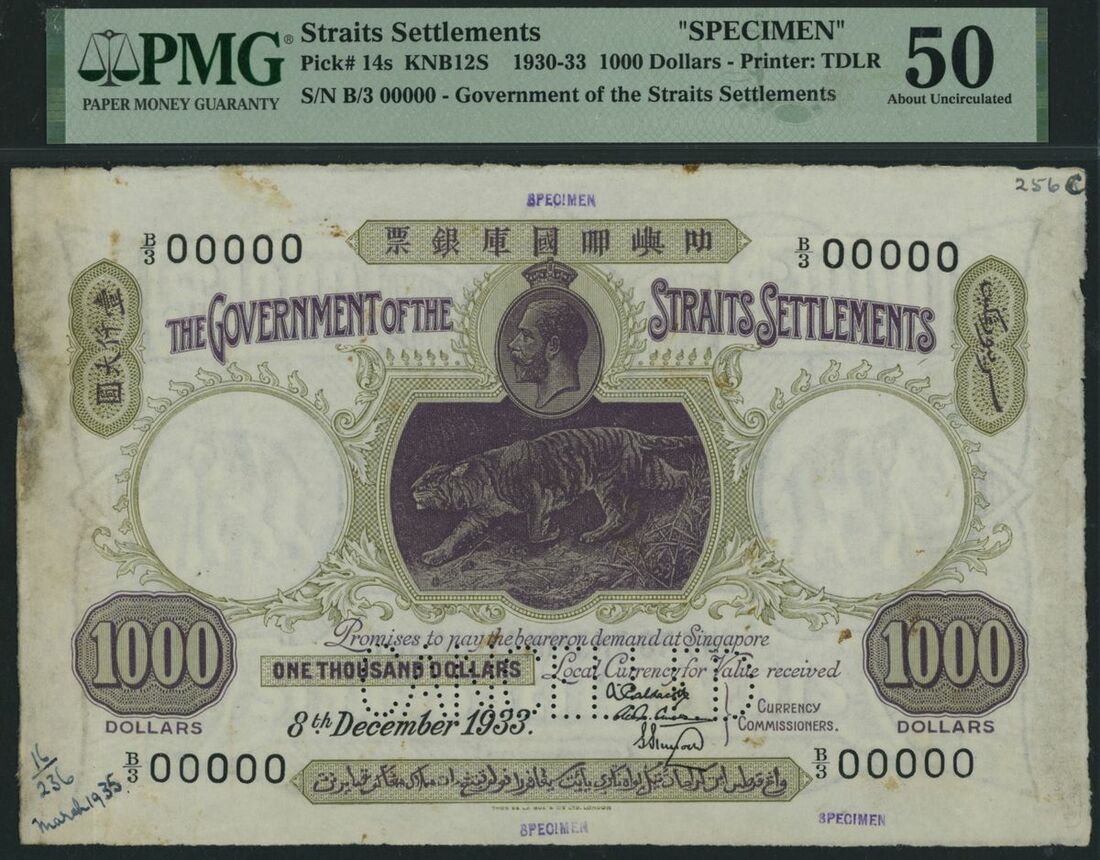Auction: 24009 - World Banknotes
Lot: 448
(x) Government of the Straits Settlements, specimen 1000 Dollars, 8th December 1933, serial number B/3 00000,
the Straits Settlements were a group of British colonial territories in Southeast Asia, comprising Penang, Singapore, and Malacca. They played a significant role in the region’s economic and political development. Established in 1826, these settlements became an official Crown colony in 1867, solidifying their place as vital centres for British trade and administration. The government of the Straits Settlements was responsible for various aspects of governance, including the issuance of currency, which served as an essential tool for maintaining control and facilitating commerce. This banknote, issued by this government in 1933, reflects a fascinating period marked by socio-political changes, economic turmoil, and increasing tensions across Asia.
In the 1930s, the Straits Settlements faced several challenges, both global and regional, that profoundly impacted the colony. The Great Depression, which began in 1929, had a devastating effect on economies worldwide, and the Straits Settlements were no exception. As a central trading hub, especially through Singapore, the region’s economy was heavily dependent on international commerce. The collapse in global demand, particularly for commodities like rubber and tin, which were two of the Straits Settlements’ primary exports, led to widespread economic distress. The decline in rubber and tin prices caused industries to falter, resulting in unemployment, poverty, and social unrest throughout the region.
Amidst this economic crisis, political change was also brewing. Nationalist movements and anti-colonial sentiments were on the rise, not only in Southeast Asia but across the broader Asian region. The British colonial government maintained its firm control, yet there was a growing demand for greater political representation, particularly from the significant Indian and Chinese communities that had established themselves within the Straits Settlements. These communities, along with other local groups, began to press for more rights, and the economic hardships only fuelled their calls for political and social reforms. Labor unrest became increasingly common as workers sought better wages and working conditions amidst the global downturn.
The external geopolitical landscape also added to the growing uncertainty. Japan’s imperial ambitions posed a mounting threat to British colonial interests in Asia. The invasion of Manchuria by Japan in 1931 marked the beginning of a more aggressive expansionist policy, and this raised alarm in the Straits Settlements. Singapore, as a critical British outpost, was seen as a vital strategic location in Southeast Asia, and by the early 1930s, British authorities had already begun fortifying the island in anticipation of possible Japanese invasion. The shadow of war loomed over the region, influencing many of the decisions made by the colonial government.
Despite these challenges, the Straits Settlements retained their importance as a hub of international trade. Singapore, in particular, continued to be a major port, attracting traders and merchants from around the world. However, the economic hardships of the Depression forced the colonial government to rethink its strategies. There was a push to diversify the economy beyond its reliance on rubber and tin, as well as efforts to stabilise trade relations with other global markets. Infrastructure development was also prioritised, with expansions to the ports and other facilities aimed at ensuring that the Straits Settlements remained competitive in an increasingly difficult global market.
Culturally, the Straits Settlements were a melting pot of different ethnicities and nationalities. The population was a diverse mix of Malays, Chinese, Indians, and Europeans, each contributing to the region's unique social and economic fabric. While this diversity fostered a vibrant cultural exchange and rich trading environment, it also posed challenges for the colonial authorities. Economic disparity, particularly during the Depression, exacerbated tensions between different ethnic groups, especially in urban centres like Singapore. The economic struggles of the time made competition for resources fiercer, and social unrest became more common as the various communities coped with the difficulties of the decade.
Amid this backdrop, the issuance of banknotes by the government of the Straits Settlements, such as this 1000 Dollars specimen note dated 8th December 1933, was a significant event. The note, bearing the serial number B/3 00000, was not intended for circulation but served as a specimen, likely used for archival purposes or as a reference for official use. Despite not being issued for public use, this note still had a remarkable face value. At the time, 1000 Straits Dollars held immense purchasing power, sufficient for acquiring property, making large business investments, or purchasing substantial quantities of goods. While exact equivalencies are challenging to calculate, 1000 Straits Dollars in the 1930s could likely be compared to tens of thousands, if not more, in today's terms.
This note is extraordinarily rare. To date, only two examples of this particular type have been certified by PMG (Paper Money Guaranty), underscoring its scarcity and significance among collectors and historians alike,
(Pick 14s, BNB 113ds), in PMG holder 50 About Uncirculated, printer's annotations, previously mounted, one of only two notes currently graded for this type on PMG Census, a rare note in any grade!
Subject to 5% tax on Hammer Price in addition to 20% VAT on Buyer’s Premium.
Estimate
£45,000 to £65,000







